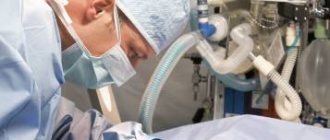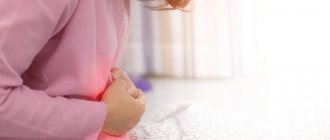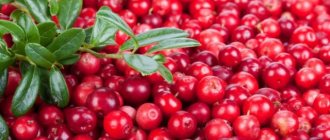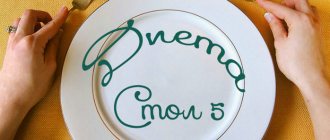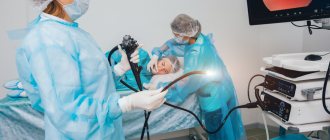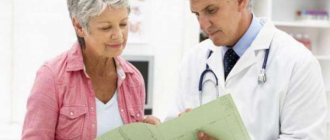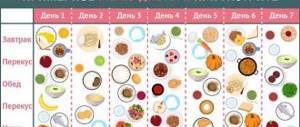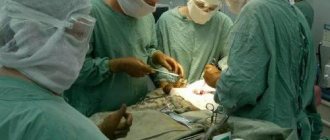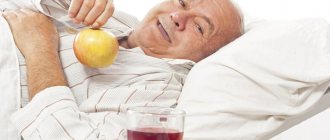General rules
Diverticular disease (or diverticulosis ) is a pathological process affecting the intestines, a characteristic feature of which is the presence of protrusions of the intestinal wall.
Multiple pouch-like protrusions (diverticula) affect the mucous and submucous membranes and can be located in any hollow organ (intestines, gall bladder, bladder). However, their localization in the intestines is most common and can be observed in all parts of the digestive tract. The cause of the formation of protrusions is the weakness of the connective tissue of the intestinal wall, which develops with age. These changes are found in 80% of elderly people. In addition, impaired intestinal motor function (tendency to constipation ) leads to increased pressure inside the intestines and the appearance of protrusions in places of least resistance.
This disease is believed to be a consequence of poor diet. When consuming refined foods low in fiber, long-term constipation occurs, which leads to overstretching of the intestinal wall. If a chronic inflammatory process is present, then morphological changes occur in the intestinal wall. A sedentary lifestyle only aggravates the situation - intestinal motility and fecal passage slow down. In this regard, the appointment of therapeutic nutrition is of great importance in the treatment of this disease.
Diet for intestinal diverticulosis
Diverticulosis of the colon is more common than that of the small intestine. The main section of the large intestine is the colon. The length of the colon is 1.5 m, and it has sections: the ascending colon, transverse colon and sigmoid colon. The colon does not take part in digestion, but water and electrolytes are absorbed here, and the liquid contents from the small intestine are converted into solid ones in the colon.
Of all its sections, diverticulosis of the sigmoid colon is more common, which is due to its anatomical and functional features: smaller diameter, a large number of bends (has the shape of the Latin letter “sigma”) and high pressure, since the sigmoid colon performs a reservoir function and the consistency of the intestinal contents in it is more dense.
Diverticulosis can occur without clinical manifestations and be an incidental finding during examination. In the presence of clinical manifestations, abdominal pain, bloating and unstable stool appear - alternating constipation , diarrhea and normal stool. With diverticulitis of the sigmoid colon, mild pain is detected in the left iliac region and often occurs after eating. After the release of gases or bowel movements, the pain may disappear or disappear completely.
If an inflammatory process appears in the wall of the diverticulum, then diverticulitis , which can be acute or chronic and is a complication of the disease. Its clinical picture is more pronounced: severe pain appears in the left iliac region, which does not disappear after defecation or the passage of gas. Persistent pain lasts for several days, the temperature rises, nausea and vomiting, and severe bloating appear.
Other complications are also possible: perforation, intestinal bleeding and intestinal obstruction . Gradually, the diverticulum enlarges, its wall stretches, becomes thin and can perforate. Stagnation of feces in the protrusion contributes to the formation of ulcers and erosions , which can be complicated by bleeding. The consequence of a long-standing disease is adhesive disease, which can be complicated by obstruction.
If the disease is asymptomatic, there is no need for special treatment. In case of diverticulitis and the presence of complaints, laxatives and regulating motor function, antispasmodics, anti-inflammatory drugs and antibiotics , drugs that normalize intestinal flora ( colibacterin , bificol or bifidumbacterin ) are prescribed. Medical nutrition is required. In most patients, conservative treatment gives a lasting effect.
In 80% of patients, the disease progresses favorably without complications throughout life. In 20%, exacerbations of the disease are observed, and with each relapse the risk of serious complications increases. In such cases, surgical treatment is proposed - resection of a section of the sigmoid colon.
Nutrition during an exacerbation
In case of an acute process or a pronounced exacerbation of a chronic disease, diet therapy depends entirely on the severity of the symptoms: from eating easily digestible food ( Diet No. 4 as for exacerbation of chronic colitis) to creating complete rest for the intestines - hunger and intravenous nutrition.
During this period, fried, spicy foods, smoked foods, canned food, any pastries, pickled and pickled vegetables, legumes and mushrooms, halva, nuts, chocolate, any seeds, kvass, carbonated drinks, coffee, sour juices and alcohol are excluded.
The diet includes:
- porridge with diluted milk or water (buckwheat, oatmeal);
- cereal soups (possibly adding pureed vegetables with coarse fiber) and dairy;
- boiled fish and lean meats and poultry in the form of minced meat, steam cutlets, soufflé;
- steam omelettes or soft-boiled eggs;
- cream, kefir, cottage cheese, yogurt, mild cheese;
- butter, olive and sunflower oils added to prepared dishes;
- boiled and pureed vegetables (potatoes, zucchini, pumpkin, carrots, cauliflower, broccoli) for soups and side dishes. Eat vegetables and fruits in small portions. In the first week after an exacerbation, they are used only after thermal cooking. Subsequently, they include coarse fruits without peel in the form of puree, finely grated carrots, fresh pumpkin and zucchini;
- sweet fruits and berries can be consumed in the form of jelly, baked apples (remove the skin), crushed or pureed dried fruits from compote; sugar, honey, marshmallows are allowed;
- warm weak tea with milk and sugar, bran decoction and rosehip infusion.
The diet for diverticular disease of the colon without exacerbation is balanced and contains an increased amount of plant fiber, since with diverticula the intestine slows down its evacuation function, constipation appears, which leads to progression of the disease.
- The consumption of plant fiber should be in the range of 30–35 g per day and it should be obtained from vegetables, fruits and grains (brown rice, sprouted grains, wholemeal bread). It is desirable to include wheat bran in the diet, which reduces intracavitary pressure and significantly accelerates the rate of movement of intestinal contents, thereby preventing its stagnation and increased pressure in the intestinal cavity. To a greater extent, this effect is exerted by coarsely ground bran.
- The amount of fiber should be increased gradually, and it is better to add bran and sprouted grains to dishes rather than eat them in their natural form, as there may be an increase in pain and flatulence .
- If tolerated, seaweed can be consumed.
- Drink plenty of fluids (1.5-2 liters per day) in the absence of contraindications.
- For constipation, be sure to include beets, prunes, and seaweed in your diet. Lactulose is the drug of choice if you are prone to constipation, but its preparations need to be used short-term, and they do not replace a diet with a high content of fiber and water.
- It is important to exclude foods that cause flatulence (legumes, lentils, raisins, grapes, onions, whole milk, cabbage, fruits with peels).
- For diverticula, it is necessary to exclude foods that cause constipation (blueberries, rice, strong tea, dogwood, jelly).
- You should exclude seeds and fruits with a large number of grains, which are not digested and irritate the intestinal mucosa.
- Vegetables and fruits containing excessively coarse fiber (pineapples, persimmons, turnips, radishes, radishes) should be excluded from the diet.
Maintaining a healthy eating schedule
If a patient is diagnosed with diverticulosis without associated complications, then increased consumption of fibrous foods is suggested. Such measures will prevent the progression of the disease and improve the general well-being of the patient. In order for the menu to be complete and balanced, you need to take into account a number of features:
- Introducing restrictions on products that contribute to excessive gas formation. It will be difficult to make a specific list; it is better to focus on the individual characteristics of the patient. Often the list of provocateurs includes seeds, nuts and seeds. You can also add vegetables or fruits that have an excessively coarse structure: cabbage, legumes.
- Provided that the patient’s intestinal function is impaired and regular constipation occurs, it is worth adding dried fruits and fermented milk products to the menu. Water balance is also necessary; you need to drink a certain amount of clean still water per day.
- Gastroenterologists suggest focusing on products with high-quality dietary fiber. Well-known sources of fiber include sprouted grains, bran and seaweed. If there is no intolerance, then you can add herbal products from any group. In order for fiber to pass well through all parts of the digestive tract, you should drink enough water to swell it.
- When fiber products are added, the patient looks at the reaction of the body and intestines. In the initial period, there may be bloating and some pain in the abdominal area. Within a few days the situation will stabilize and the symptoms will subside.
The treatment table of the 5th diet was developed taking into account maintaining the digestive system in normal shape. Eating according to a similar scheme involves choosing foods from a certain group with acceptable food temperatures. The frequency of meals is taken into account; there should be no long breaks. If the instructions are followed, the bile begins to drain without problems, and stagnation does not occur.
List of correct and prohibited foods
The set of products is standard for situations where there are problems with the digestive system. It is necessary to take into account the fact when the disease occurs in an acute form or an exacerbation of diverticulosis occurs.
Authorized Products
- The diet involves eating almost all vegetables: beets, carrots, lettuce, cucumbers, tomatoes, pumpkins, zucchini, cauliflower. They can be used raw, stewed and boiled. If the patient tolerates white cabbage well, then it can be consumed in small quantities, but only in stewed form. You can make vegetable caviar and stew from vegetables.
- Sufficient dietary fiber can be obtained by eating 200 g of whole grain bread, 250 g of fruit, 200 g of potatoes, 40 g of cereal (oatmeal or buckwheat) and 250 g of vegetables per day. Increasing your fiber intake may initially relieve pain and bloating. When diarrhea occurs, fiber intake is limited.
- Seaweed can be consumed dried (1-3 tsp per day, after soaking in water), adding to salads.
- The first courses are prepared in vegetable or secondary meat/fish broth. Since you need to include more fiber in your diet, you should prepare vegetable first courses more often.
- For main courses, preference is given to lean meats, chicken, and turkey, since lean meat is easier to digest. Meat and fish dishes can be cooked boiled or baked. Remember that any meat is a difficult product to digest compared to fish; therefore, eating it daily is undesirable, especially if you are prone to constipation. In this case, preference should be given to fish dishes. No less important is the method of cooking them. Fish and meat should be cooked in pieces - this makes them easier to digest than minced meat.
- From cereals (buckwheat, millet, pearl barley, barley, wheat) crumbly porridges, casseroles and porridges with the addition of milk are prepared. Porridges should be crumbly, since “smear porridges” or mashed potatoes move slowly through the intestines.
- Fermented milk drinks contain large amounts of organic acids, so they are useful for constipation. The following should be present in the diet every day: kefir, yogurt, matsoni, kumiss, acidophilus yogurt.
- Milk is allowed only in dishes and in diluted form, as it can cause flatulence.
- Fresh cottage cheese and dishes made from it are welcome: puddings and casseroles. Cream and sour cream are allowed only as an additive to dishes.
- You can eat up to 2 eggs per day, but cook them in the form of steamed omelettes, soft-boiled or omelettes with vegetables.
- The diet should contain unlimited quantities of fresh sweet fruits and berries, soaked dried fruits (dried apricots, prunes, apricots, figs). Among sweets, jam, marmalade, honey, marshmallows, and milk caramel are allowed.
- Wheat bread (made from second grade flour), grain bread, doctor's bread is allowed, and if tolerated well, rye bread is also allowed. All bread products must be yesterday's baked goods. You can eat unsweetened cookies (biscuits) and dry biscuits.
- Mineral waters, weak tea, coffee substitutes, bran decoction, rosehip infusion, juices (plum, apricot, carrot, beetroot, tomato and others) are allowed.
Table of permitted products
| Proteins, g | Fats, g | Carbohydrates, g | Calories, kcal | |
Vegetables and greens | ||||
| zucchini | 0,6 | 0,3 | 4,6 | 24 |
| cauliflower | 2,5 | 0,3 | 5,4 | 30 |
| carrot | 1,3 | 0,1 | 6,9 | 32 |
| pickles | 0,8 | 0,1 | 1,7 | 11 |
| beet | 1,5 | 0,1 | 8,8 | 40 |
| tomatoes | 0,6 | 0,2 | 4,2 | 20 |
| pumpkin | 1,3 | 0,3 | 7,7 | 28 |
Fruits | ||||
| apricots | 0,9 | 0,1 | 10,8 | 41 |
| watermelon | 0,6 | 0,1 | 5,8 | 25 |
| bananas | 1,5 | 0,2 | 21,8 | 95 |
| melon | 0,6 | 0,3 | 7,4 | 33 |
| nectarine | 0,9 | 0,2 | 11,8 | 48 |
| peaches | 0,9 | 0,1 | 11,3 | 46 |
| plums | 0,8 | 0,3 | 9,6 | 42 |
| apples | 0,4 | 0,4 | 9,8 | 47 |
Nuts and dried fruits | ||||
| dried figs | 3,1 | 0,8 | 57,9 | 257 |
| dried apricots | 5,2 | 0,3 | 51,0 | 215 |
| dried apricots | 5,0 | 0,4 | 50,6 | 213 |
| prunes | 2,3 | 0,7 | 57,5 | 231 |
Cereals and porridges | ||||
| buckwheat (kernel) | 12,6 | 3,3 | 62,1 | 313 |
| oat groats | 12,3 | 6,1 | 59,5 | 342 |
| corn grits | 8,3 | 1,2 | 75,0 | 337 |
| pearl barley | 9,3 | 1,1 | 73,7 | 320 |
| wheat bran | 15,1 | 3,8 | 53,6 | 296 |
| millet cereal | 11,5 | 3,3 | 69,3 | 348 |
| barley grits | 10,4 | 1,3 | 66,3 | 324 |
Bakery products | ||||
| oatmeal bread | 10,1 | 5,4 | 49,0 | 289 |
| Rye bread | 6,6 | 1,2 | 34,2 | 165 |
| bran bread | 7,5 | 1,3 | 45,2 | 227 |
| doctor's bread | 8,2 | 2,6 | 46,3 | 242 |
| whole grain bread | 10,1 | 2,3 | 57,1 | 295 |
Confectionery | ||||
| jam | 0,3 | 0,2 | 63,0 | 263 |
| jelly | 2,7 | 0,0 | 17,9 | 79 |
| marshmallows | 0,8 | 0,0 | 78,5 | 304 |
| milk candies | 2,7 | 4,3 | 82,3 | 364 |
| fondant candies | 2,2 | 4,6 | 83,6 | 369 |
| fruit and berry marmalade | 0,4 | 0,0 | 76,6 | 293 |
| paste | 0,5 | 0,0 | 80,8 | 310 |
| Maria cookies | 8,7 | 8,8 | 70,9 | 400 |
| oatmeal cookies | 6,5 | 14,4 | 71,8 | 437 |
Raw materials and seasonings | ||||
| honey | 0,8 | 0,0 | 81,5 | 329 |
| sugar | 0,0 | 0,0 | 99,7 | 398 |
| milk sauce | 2,0 | 7,1 | 5,2 | 84 |
| sour cream sauce | 1,9 | 5,7 | 5,2 | 78 |
Dairy | ||||
| milk | 3,2 | 3,6 | 4,8 | 64 |
| kefir | 3,4 | 2,0 | 4,7 | 51 |
| cream | 2,8 | 20,0 | 3,7 | 205 |
| sour cream | 2,8 | 20,0 | 3,2 | 206 |
| curdled milk | 2,9 | 2,5 | 4,1 | 53 |
| kumiss | 3,0 | 0,1 | 6,3 | 41 |
| acidophilus | 2,8 | 3,2 | 3,8 | 57 |
| yogurt | 4,3 | 2,0 | 6,2 | 60 |
Cheeses and cottage cheese | ||||
| cottage cheese | 17,2 | 5,0 | 1,8 | 121 |
Meat products | ||||
| beef | 18,9 | 19,4 | 0,0 | 187 |
| beef liver | 17,4 | 3,1 | 0,0 | 98 |
| beef tongue | 13,6 | 12,1 | 0,0 | 163 |
| veal | 19,7 | 1,2 | 0,0 | 90 |
| rabbit | 21,0 | 8,0 | 0,0 | 156 |
Bird | ||||
| chicken | 16,0 | 14,0 | 0,0 | 190 |
| turkey | 19,2 | 0,7 | 0,0 | 84 |
Eggs | ||||
| chicken eggs | 12,7 | 10,9 | 0,7 | 157 |
Fish and seafood | ||||
| herring | 16,3 | 10,7 | — | 161 |
Oils and fats | ||||
| butter | 0,5 | 82,5 | 0,8 | 748 |
| corn oil | 0,0 | 99,9 | 0,0 | 899 |
| olive oil | 0,0 | 99,8 | 0,0 | 898 |
| sunflower oil | 0,0 | 99,9 | 0,0 | 899 |
Non-alcoholic drinks | ||||
| mineral water | 0,0 | 0,0 | 0,0 | — |
| instant chicory | 0,1 | 0,0 | 2,8 | 11 |
| black tea with milk and sugar | 0,7 | 0,8 | 8,2 | 43 |
Juices and compotes | ||||
| apricot juice | 0,9 | 0,1 | 9,0 | 38 |
| carrot juice | 1,1 | 0,1 | 6,4 | 28 |
| plum juice | 0,8 | 0,0 | 9,6 | 39 |
| tomato juice | 1,1 | 0,2 | 3,8 | 21 |
| pumpkin juice | 0,0 | 0,0 | 9,0 | 38 |
| rose hip juice | 0,1 | 0,0 | 17,6 | 70 |
| * data is per 100 g of product | ||||
Diet result
Diet is a powerful helper for the body during exacerbation of intestinal disease. Proper nutritional therapy helps to get rid of the symptoms of the disease, and sometimes completely cure intestinal diverticulosis even without drug intervention. But drug treatment without diet is much less effective.
The disease can be prevented with proper nutrition. By consuming healthy foods in moderation and at the right time, you can make your body highly resistant to various diseases. After treatment for the disease, especially after diverticulitis, you should stick to the therapeutic diet for some more time, or better yet, completely reconsider your diet for the rest of your life.
Fully or partially limited products
- Spicy dishes, sauces, horseradish and mustard greatly irritate the mucous membranes and disrupt the function of the gastrointestinal tract. You should limit foods that cause constipation - rice, semolina, noodles, sago, vermicelli, potatoes, as well as legumes, which can cause bloating.
- You should exclude dishes with a viscous consistency - these are slimy soups, mashed potatoes, mashed porridges and jelly, as they move slowly through the intestines.
- They stay in the stomach for a long time and are difficult to digest fatty types of meat (duck, goose) and fish, canned food, smoked meats, hard-boiled and fried eggs. In this regard, they must be excluded from the diet.
- Also excluded are dishes containing tannins - strong tea, cocoa and coffee, jelly from quince, pears, bird cherry, blueberries, dogwood.
- Chocolate and all kinds of products with cream are also not allowed. It is worth excluding bread made from high-grade flour, as well as baked goods made from yeast dough and puff pastry, and eating unsweetened pastries is limited.
- You should avoid vegetables rich in essential oils and coarse fiber (onions, radishes, turnips, radishes, peppers), as well as mushrooms.
- Limit the consumption of animal fats and give preference to vegetable ones.
- Consumption of alcoholic beverages is prohibited.
Table of prohibited products
| Proteins, g | Fats, g | Carbohydrates, g | Calories, kcal | |
Vegetables and greens | ||||
| vegetables legumes | 9,1 | 1,6 | 27,0 | 168 |
| cabbage | 1,8 | 0,1 | 4,7 | 27 |
| radish | 1,2 | 0,1 | 3,4 | 19 |
| white radish | 1,4 | 0,0 | 4,1 | 21 |
| turnip | 1,5 | 0,1 | 6,2 | 30 |
| horseradish | 3,2 | 0,4 | 10,5 | 56 |
| garlic | 6,5 | 0,5 | 29,9 | 143 |
Fruits | ||||
| quince | 0,6 | 0,5 | 9,8 | 40 |
| dogwood | 1,0 | 0,0 | 10,5 | 44 |
Berries | ||||
| grape | 0,6 | 0,2 | 16,8 | 65 |
| blueberry | 1,1 | 0,4 | 7,6 | 44 |
Mushrooms | ||||
| mushrooms | 3,5 | 2,0 | 2,5 | 30 |
Nuts and dried fruits | ||||
| raisin | 2,9 | 0,6 | 66,0 | 264 |
Cereals and porridges | ||||
| semolina | 10,3 | 1,0 | 73,3 | 328 |
| rice | 6,7 | 0,7 | 78,9 | 344 |
| sago | 1,0 | 0,7 | 85,0 | 350 |
Flour and pasta | ||||
| pasta | 10,4 | 1,1 | 69,7 | 337 |
| noodles | 12,0 | 3,7 | 60,1 | 322 |
Bakery products | ||||
| wheat bread | 8,1 | 1,0 | 48,8 | 242 |
Confectionery | ||||
| pastry cream | 0,2 | 26,0 | 16,5 | 300 |
Chocolate | ||||
| chocolate | 5,4 | 35,3 | 56,5 | 544 |
Raw materials and seasonings | ||||
| mustard | 5,7 | 6,4 | 22,0 | 162 |
| mayonnaise | 2,4 | 67,0 | 3,9 | 627 |
Meat products | ||||
| pork | 16,0 | 21,6 | 0,0 | 259 |
| salo | 2,4 | 89,0 | 0,0 | 797 |
Sausages | ||||
| dry-cured sausage | 24,1 | 38,3 | 1,0 | 455 |
Bird | ||||
| smoked chicken | 27,5 | 8,2 | 0,0 | 184 |
| duck | 16,5 | 61,2 | 0,0 | 346 |
| smoked duck | 19,0 | 28,4 | 0,0 | 337 |
| goose | 16,1 | 33,3 | 0,0 | 364 |
Fish and seafood | ||||
| smoked fish | 26,8 | 9,9 | 0,0 | 196 |
| canned fish | 17,5 | 2,0 | 0,0 | 88 |
Oils and fats | ||||
| animal fat | 0,0 | 99,7 | 0,0 | 897 |
| cooking fat | 0,0 | 99,7 | 0,0 | 897 |
Non-alcoholic drinks | ||||
| instant coffee dry | 15,0 | 3,5 | 0,0 | 94 |
| black tea | 20,0 | 5,1 | 6,9 | 152 |
Juices and compotes | ||||
| jelly | 0,2 | 0,0 | 16,7 | 68 |
| * data is per 100 g of product | ||||
What you can't eat or should limit
With diverticulosis of the large intestine, you need to completely avoid foods that disrupt the digestion process or irritate the intestinal mucosa, causing flatulence and bloating.
| Porridge | Brown rice, semolina, sago. |
| Soups | Fatty broths, pea soups for flatulence. |
| Meat | Lard, duck and goose meat, canned food, fried and smoked foods, sausages. |
| Eggs | Hard-boiled, scrambled eggs. |
| Dairy | Hard or sharp cheese, sometimes milk. |
| Vegetables | Cabbage (not always well tolerated), horseradish, radish, radishes, beans, peas, mashed potatoes, onions. Mushrooms. |
| Fruits and berries | Peel, berries with small seeds, quince, dogwood, grapes, blueberries, raisins. |
| Beverages | Coffee, strong tea, cocoa, hot chocolate, alcohol, carbonated drinks, jelly. |
With diverticulosis of the sigmoid colon (namely, it is in this part of the large intestine that protrusion of the mucous membrane most often occurs), fast food and snacks (chips, nuts) are strictly prohibited. If some foods are not included in the list of prohibited foods, but provoke digestive problems, they should be avoided, regardless of standard recommendations.
Power Menu (Power Mode)
Taking into account the list of recommended products, you can create a menu. Every day you need to take juices with pulp, dried fruit compote, infusion of prunes or rose hips. If you have constipation at night, you need to consume kefir daily with the addition of wheat bran (1 tbsp - 2 tbsp), they can also be added to dishes.
Depending on the condition of the intestines (constipation or normal stool), you can increase or decrease the amount of bran in the diet. For the whole day you can consume 200 g of wholemeal bread, 200 g of rye bread and up to 50 g of sugar.
Monday
| Breakfast |
|
| Lunch |
|
| Dinner |
|
| Dinner |
|
| For the night |
|
Tuesday
| Breakfast |
|
| Lunch |
|
| Dinner |
|
| Dinner |
|
| For the night |
|
Wednesday
| Breakfast |
|
| Lunch |
|
| Dinner |
|
| Dinner |
|
| For the night |
|
Approximate composition of the dietary menu by day of the week
When creating a menu, you should take into account the localization of the inflammatory process in the intestines. Doctors explain this need by the difference in food digestion processes in different parts of the gastrointestinal tract.
The following approximate menu composition is distinguished depending on the location of the pathological process:
| Disease | Breakfast | First snack | Dinner | Second snack | Dinner |
| Diverticulosis of the rectum | Kefir, 2 boiled eggs | Cottage cheese with dried fruits | Vegetable soup | Yogurt | Vegetable stew, herbal decoction |
| Colon diverticulosis | Low-fat cottage cheese casserole, green tea | Kefir | Soup from lean fish or meat, cheesecakes | Banana, apple | Potatoes, boiled fish |
| Small intestinal diverticulosis | Rice porridge, freshly squeezed plum juice | Cottage cheese with sour cream | Vegetable puree soup | Kefir | Steamed vegetables and fish |
During the first day after switching to a dietary food regimen, flatulence and painful sensations in the epigastric region are noted. Since this is a natural reaction of the body to a change in diet, this condition is considered normal in gastroenterology.
It is recommended to plan your meal schedule for the week ahead. Such measures will help calculate the amount of calories consumed, the balance of vitamins and microelements.
Experts suggest that patients with intestinal diverticulosis take the following weekly menu as a basis:
| Day of the week | Nutrition composition |
| Monday | The diet should consist of liquid soups, cereals, and light vegetable salads. Throughout the day you can drink green tea and eat 2 bananas |
| Tuesday | Low-fat fermented milk products, banana, oat biscuits |
| Wednesday | You should stick to the apple diet and eat about 3 kg of fresh fruits |
| Thursday | Fish or chicken broth, porridge with vegetables |
| Friday | Fresh watermelon, baked pumpkin, cottage cheese |
| Saturday | Boiled eggs or omelet, lean borscht or buckwheat porridge |
| Resurrection | Boiled lean meat, vegetables, kefir |
Reviews and results
The effectiveness of this nutrition has been appreciated by many, so the reviews and results are positive. Everyone notes that the diet is easy to tolerate and feasible in everyday life. The main thing is to choose vegetables and fruits that will be well tolerated and will not cause intestinal pain and bloating.
- “... I have been suffering from constipation for many years and lately I have started to worry about pain in my left abdomen, which gets worse after eating. With age, the problem worsened - many foods began to be poorly tolerated (milk, cabbage, legumes, grapes and grape juice) - all this began to cause bloating. After examination, a diagnosis of sigmoiditis and diverticulosis was made. I am convinced that dietary nutrition is very important for these diseases. If the diet is violated, pain and discomfort in the intestines again bother me, so I began to carefully monitor my diet”;
- “... I have been worried about constipation for many years, and this disease was recently discovered. I realized that I need to watch my diet, because bread, buns and pasta make me stronger and cause pain in my intestines. Diet and drinking water helps a lot. I can’t stand a lot of fresh vegetables - they cause pain and bloating. I liked the boiled beets and seaweed in salads”;
- “... A year ago I was diagnosed with diverticular disease. I was worried about pain in the intestines, mostly on the left, and constipation. They prescribed a diet and pills. With this diet, normal stool is restored within 5 days. And since I have a tendency to constipation, I need to constantly monitor my diet. At night I always drink kefir with bran, eat figs and prunes. I excluded fried and smoked foods, I don’t eat cabbage, radishes and radishes, as pain in the intestines immediately appears. I can say that thanks to nutrition, there has been no exacerbation for 2 years.”
The importance of nutritional therapy for diverticulosis
Doctors have not yet fully studied all the causes of diverticulosis. However, it has been noted that this intestinal pathology practically does not occur among representatives of African peoples, because the basis of their diet is plant products. The disease is typical in Western countries, where residents eat heavy animal foods and baked goods. It is for this reason that insufficient fiber intake into the body is the main problem that the diet struggles with.
Recent medical studies have confirmed that regular consumption of dietary fiber in large quantities will reduce the likelihood of developing intestinal cancer. This is due to the fact that fiber removes carcinogens from the body before they begin to have a negative effect. This is why it is important to eat right to ensure effective prevention of diverticulosis and rapid recovery of the intestines.
Diverticula in the intestine
Nutrition during an exacerbation of the disease
During an exacerbation of the disease, nutrition is determined by the severity of symptoms. In acute diverticulitis, gentle table No. 4 is indicated. In severe cases, the patient is prescribed fasting for several days or intravenous nutrition. Diet No. 4 excludes fried foods, smoked foods, baked goods, marinades, raw and pickled vegetables, sour juices, and coffee. Menu includes:
- porridge with water;
- milk soups;
- cream soups from tomatoes, pumpkin, potatoes;
- boiled fish, poultry;
- steam omelettes, soft-boiled eggs;
- low-fat fermented milk products;
- soft fresh or baked fruits;
- marshmallow;
- honey;
- warm tea;
- pureed non-acidic berries.
Diverticulosis refers to a disease that affects the walls of the large intestine. With the development of this pathology, the intestine changes externally, as various protrusions form on it.
Unfortunately, it is no longer possible to cure the disease. But you can prevent the occurrence of complications. For this purpose, a special diet is prescribed for intestinal diverticulosis.
What diet does intestinal diverticulosis require?
Diverticulosis is a disease in which multiple protrusions appear in the wall of the colon. This is not due to congenital causes, but to long-term malnutrition of an adult, which creates high intraintestinal pressure.
A diverticulum is a protrusion of the intestinal wall that appears from poor nutrition
It is no longer possible to correct the situation - the diverticula will not “retract” back. But preventing possible complications and preventing the formation of new hernia-like areas is an entirely achievable goal. And only a diet for intestinal diverticulosis can accomplish this.
Where does everyone start?
A gastroenterologist should select nutrition, taking into account the condition of the intestines:
- decreased or increased tone of the intestinal wall,
- the basis for the development of diverticula was thinning of the intestinal wall or disease of the entire connective tissue,
- are there any inflammatory complications (diverticulitis),
- what microflora predominates inside the intestinal cavity.
Warning! To do this, you need to undergo some preliminary studies: colonoscopy (endoscopic, virtual or capsule), X-ray contrast study, general and biochemical blood tests.
Based on the data obtained, the following options can be selected:
- if reduced intestinal tone predominates and its wall is thinned, the diet should contain a lot of plant fiber and at least 1.5 liters of liquid;
- if the coordination of the work of different parts of the intestine is impaired, which is most often a consequence of dysbiosis, the diet should include more fermented milk products, as well as ballast substances. At the same time, you should try to eat food at the same time;
- if diverticulosis is complicated by inflammation of the mucous membrane of intestinal protrusions, a diet with a minimum amount of waste and fiber is necessary.
Therapeutic diet for intestinal inflammation
Principles of nutrition
To prevent the progression of the disease and the development of complications, the diet for diverticulosis must meet the following requirements:
- take food often, in small quantities;
- products that are ground or otherwise crushed should predominate: so that each piece is better coated with enzymes and digested without increasing intestinal pressure;
- puree soups and milk porridges are the basis of the diet;
- there should be a lot of bran, vegetables, berries, fruits or dishes made from them - they contain plant fiber;
- You need to drink enough liquid between meals. And this is not only water, but also juices, jelly, and rosehip decoction;
- for constipation, preference should be given not to laxatives, but to herbal teas, prunes and plum juice;
- It is necessary to avoid alcohol, caffeine-containing products and the use of seeds.
If you have diverticulosis, it is very important to eat at the same time every day.
Since the basis of nutrition for diverticulosis is the consumption of dietary fiber (fiber), but it is difficult to immediately change your eating habits, we offer the following rules for switching to high-fiber foods:
- Replace white bread with bran bread;
- If you want to eat sweets, take berries, bananas, peaches;
- Replace apple juice with raw, peeled apple;
- Avoid peeling apples and pears before baking;
- You can add raw bran to your food, which is sold in stores and pharmacies;
- Eat more vegetables, fruits;
- It is advisable to prepare soups vegetarian, adding barley to them;
- Replace some of the beef in dishes (especially casseroles) with beans;
- For dessert, eat not sweets and cakes, but dried apricots, raisins, and nuts in small quantities.
Advice! You don't need to follow all of these recommendations at once - make it a rule to introduce one of them every 6 weeks. Don't be alarmed if your bloating gets worse in the first few weeks. This is a normal reaction of the intestines to changes in diet.
Prohibited and permitted products
Food for diverticulosis should contain a lot of fiber and be ground
To further explain what nutrition should be like for intestinal diverticulosis, we provide a list of permitted and undesirable foods for consumption.
